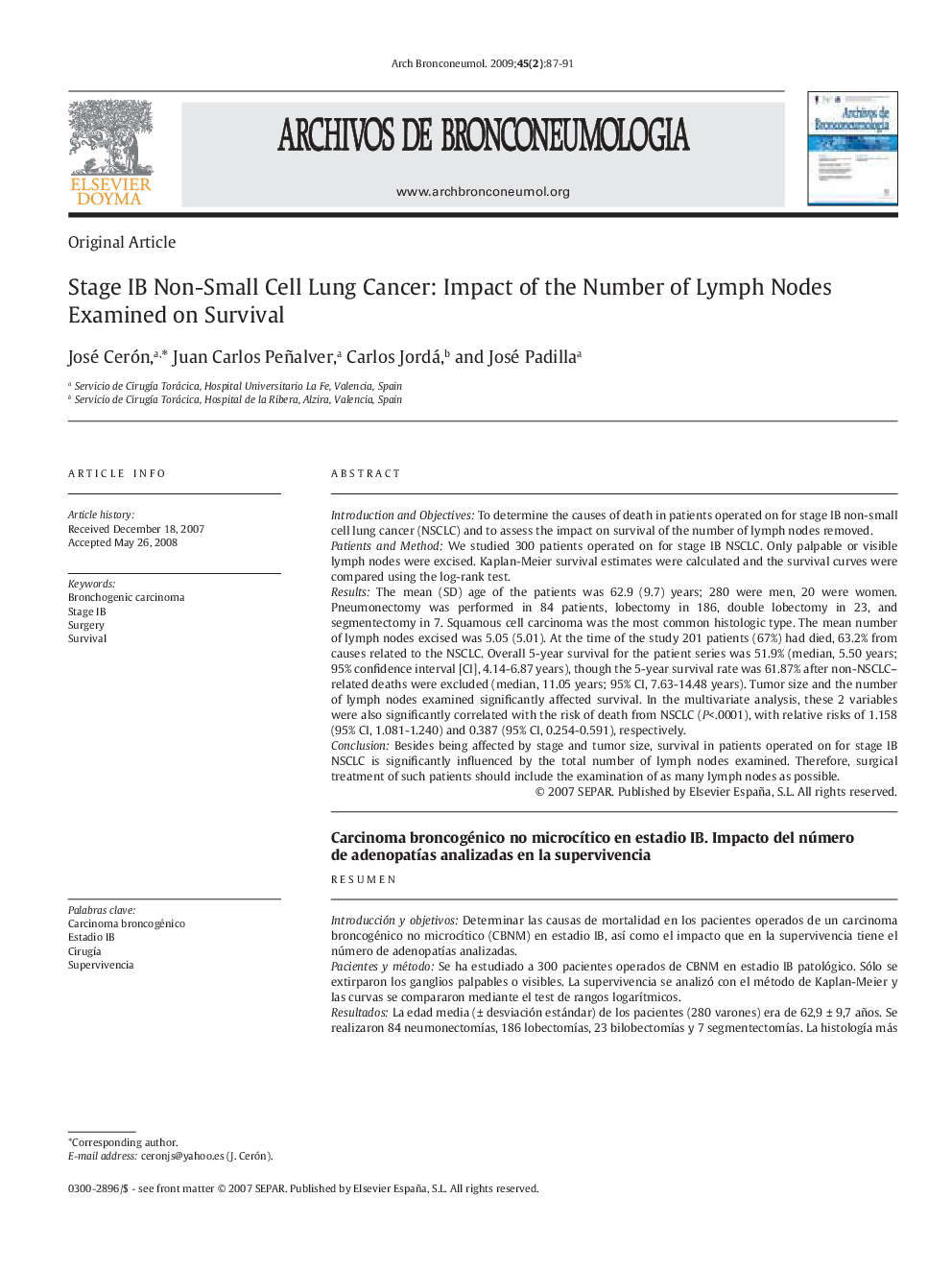| Article ID | Journal | Published Year | Pages | File Type |
|---|---|---|---|---|
| 4206805 | Archivos de Bronconeumología (English Edition) | 2009 | 5 Pages |
Introduction and ObjectivesTo determine the causes of death in patients operated on for stage IB non-small cell lung cancer (NSCLC) and to assess the impact on survival of the number of lymph nodes removed.Patients and MethodWe studied 300 patients operated on for stage IB NSCLC. Only palpable or visible lymph nodes were excised. Kaplan-Meier survival estimates were calculated and the survival curves were compared using the log-rank test.ResultsThe mean (SD) age of the patients was 62.9 (9.7) years; 280 were men, 20 were women. Pneumonectomy was performed in 84 patients, lobectomy in 186, double lobectomy in 23, and segmentectomy in 7. Squamous cell carcinoma was the most common histologic type. The mean number of lymph nodes excised was 5.05 (5.01). At the time of the study 201 patients (67%) had died, 63.2% from causes related to the NSCLC. Overall 5-year survival for the patient series was 51.9% (median, 5.50 years; 95% confidence interval [CI], 4.14-6.87 years), though the 5-year survival rate was 61.87% after non-NSCLC–related deaths were excluded (median, 11.05 years; 95% CI, 7.63-14.48 years). Tumor size and the number of lymph nodes examined significantly affected survival. In the multivariate analysis, these 2 variables were also significantly correlated with the risk of death from NSCLC (P<.0001), with relative risks of 1.158 (95% CI, 1.081-1.240) and 0.387 (95% CI, 0.254-0.591), respectively.ConclusionBesides being affected by stage and tumor size, survival in patients operated on for stage IB NSCLC is significantly influenced by the total number of lymph nodes examined. Therefore, surgical treatment of such patients should include the examination of as many lymph nodes as possible.
ResumenIntroducción y objetivosDeterminar las causas de mortalidad en los pacientes operados de un carcinoma broncogénico no microcítico (CBNM) en estadio IB, así como el impacto que en la supervivencia tiene el número de adenopatías analizadas.Pacientes y métodoSe ha estudiado a 300 pacientes operados de CBNM en estadio IB patológico. Sólo se extirparon los ganglios palpables o visibles. La supervivencia se analizó con el método de Kaplan-Meier y las curvas se compararon mediante el test de rangos logarítmicos.ResultadosLa edad media (± desviación estándar) de los pacientes (280 varones) era de 62,9 ± 9,7 años. Se realizaron 84 neumonectomías, 186 lobectomías, 23 bilobectomías y 7 segmentectomías. La histología más frecuente fue el carcinoma epidermoide. La media del número de ganglios extirpados fue 5,05 ± 5,01. En el momento del estudio, 201 pacientes (67%) habían fallecido, el 63,2% por causas relacionadas con el CBNM. La supervivencia global de la serie a los 5 años se estableció en el 51,9% (mediana: 5,50 años; intervalo de confianza [IC] del 95%, 4,14-6,87), mientras que la supervivencia a los 5 años relacionada con el CBNM se estableció en el 61,87% (mediana: 11,05 años; IC del 95%, 7,63-14,48). El tamaño tumoral y el número de adenopatías analizadas condicionaron significativamente la supervivencia. En el análisis multivariante mantuvieron la significación estadística (p < 0,0001) en su correlación con el riesgo de muerte por CBNM, con unos riesgos relativos de 1,158 (IC del 95%, 1,081-1,240) y 0,387 (IC del 95%, 0,254-0,591) respectivamente.ConclusiónAdemás del estadio y del tamaño tumoral, el número de adenopatías analizadas en total condiciona de forma significativa la supervivencia en pacientes intervenidos de CBNM en estadio IB patológico, por lo que el tratamiento quirúrgico debe incluir el análisis del mayor número posible de adenopatías.
